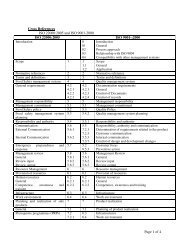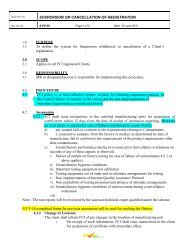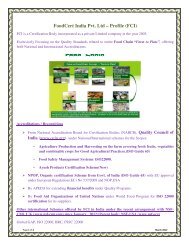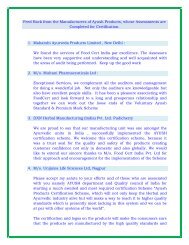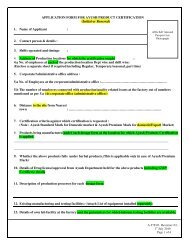Standard for Good Field Collection Practices - NMPB
Standard for Good Field Collection Practices - NMPB
Standard for Good Field Collection Practices - NMPB
Create successful ePaper yourself
Turn your PDF publications into a flip-book with our unique Google optimized e-Paper software.
1. SCOPE<br />
This standard covers <strong>Good</strong> <strong>Field</strong> <strong>Collection</strong> <strong>Practices</strong> <strong>for</strong> wild medicinal plants in sustainable<br />
manner and maintaining quality of produce used by all stakeholders.<br />
This standard does not cover the requirements <strong>for</strong> <strong>Good</strong> Agricultural <strong>Practices</strong> (GAPs)<br />
2. DEFINITIONS AND ABBREVIATIONS<br />
2.1 Definitions-For common understanding by the stakeholder in uni<strong>for</strong>m manner, applicable<br />
terms have been defined and are given in Annex A<br />
2.2 Abbreviations- Abbreviations used in this standard are given in Annex G<br />
3. REQUIREMENTS<br />
3.1 The standard provides requirements <strong>for</strong> <strong>Good</strong> <strong>Field</strong> <strong>Collection</strong> <strong>Practices</strong> on different aspects<br />
<strong>for</strong> harvesting and post harvest management of medicinal plants. The details of requirements is<br />
given in Table 01<br />
4. APPRAISALS AND ASSESMENT<br />
4.1The requirements stated in Table 01 shall be evaluated to establish that collectors comply<br />
with those requirements. An appraisal and assessment system has been developed. On evaluation<br />
of deficiencies that may appear in evaluation need to be resolved to establish compliance to the<br />
requirements. These deficiencies have been classified as:<br />
Critical:When evidence shows that the grower has not complied with requirements in its<br />
documentation and implementation and which raises doubts on the operation and practice of<br />
GAP calling <strong>for</strong> an early correction and corrective actions within the time frame.<br />
Major: When evidence suggests major break down in the implementation in certain elements of<br />
the criteria calling <strong>for</strong> the early corrective actions within a time frame<br />
Minor:When evidence shows an isolated non-compliance to the GAP criteria and has negligible<br />
impact on the operation of the system and its results.<br />
Note: Multiple Minor NCs with related impact on the operation of the system in one particular<br />
area may result in major NC<br />
4.2 To develop a self-assessment against the criteria, a checklist has been developed and is given<br />
in Table 02. This will bring uni<strong>for</strong>mity in evaluation of the system. This also indicates when a<br />
violation of a particular criteria leads to critical, major or minor noncon<strong>for</strong>mities.<br />
Page 4 of 44





